
Starlings are small to medium-sized passerine birds in the family Sturnidae, common name of Sturnid. The Sturnidae are named for the genus Sturnus, which in turn comes from the Latin word for starling, sturnus. The family contains 128 species which are divided into 36 genera. Many Asian species, particularly the larger ones, are called mynas, and many African species are known as glossy starlings because of their iridescent plumage. Starlings are native to Europe, Asia, and Africa, as well as northern Australia and the islands of the tropical Pacific. Several European and Asian species have been introduced to these areas, as well as North America, Hawaii, and New Zealand, where they generally compete for habitats with native birds and are considered to be invasive species. The starling species familiar to most people in Europe and North America is the common starling, and throughout much of Asia and the Pacific, the common myna is indeed common.

The spotless starling is a passerine bird in the starling family, Sturnidae. It is closely related to the common starling, but has a much more restricted range, confined to the Iberian Peninsula, Northwest Africa, southernmost France, and the islands of Sicily, Corsica and Sardinia. It is largely non-migratory.

The long-tailed glossy starling is a member of the starling family of birds. It is a resident breeder in tropical Africa from Senegal east to Sudan.
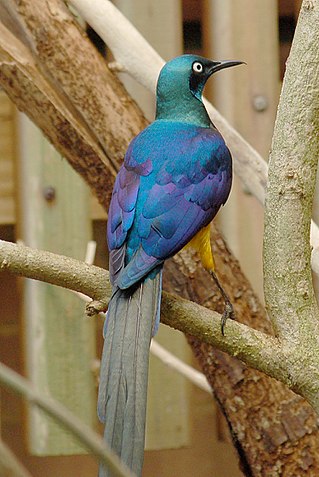
The golden-breasted starling, also known as royal starling, is a medium-sized passerine in the starling family.

The emerald starling is also known as the iris glossy starling. It is a small starling with a metallic green crown, upper body, wings and tail. The ear-coverts and underparts are metallic purple. Both sexes are similar. Most taxonomists unite it with many other glossy starlings in Lamprotornis, while others place it in a monotypic genus Coccycolius.

The Rarotonga starling is a species of starling in the family Sturnidae. It is endemic to the Cook Islands.

The long-tailed starling is a species of starling in the family Sturnidae. It is endemic to the Schouten Islands off West Papua, in Indonesia, an important area of bird endemism. The species was once treated as part of a superspecies with the shining starling. There are two subspecies, the nominate race, which occurs on Biak, and brevicauda, which is found on Numfor Island. It occurs in a wide range of habitats at all altitudes, including natural forest and forest edges, as well as human modified secondary forests and gardens. In spite of its tiny global range the species is not considered threatened by human activities and remains common within its range, and is therefore listed as least concern by the IUCN.

The short-tailed starling is a species of starling in the family Sturnidae. It is found in Indonesia and the Philippines.

The Apo myna is a species of starling in the starling family Sturnidae. The species is also known as the Mount Apo starling or the Mount Apo king starling. It is the only member of the genus Goodfellowia. It is endemic to the Philippines found only in the tropical montane forests of Mindanao. It is threatened by habitat loss.
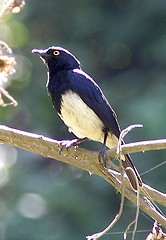
Abbott's starling is a species of starling in the family Sturnidae. It is found in Kenya and Tanzania. Its natural habitat is subtropical or tropical moist montane forests. It is threatened by habitat loss, and its population is estimated at 2500–9999. This species, at 16 to 18 cm long, is the smallest species of starling. It is in the monotypic genus Arizelopsar.

The sharp-tailed starling, also known as the sharp-tailed glossy-starling, is a species of starling in the family Sturnidae.

The bronze-tailed starling or bronze-tailed glossy-starling is a species of starling in the family Sturnidae. It is found in Benin, Burkina Faso, Cameroon, the Central African Republic, Chad, the Democratic Republic of the Congo, Gambia, Ghana, Guinea, Guinea-Bissau, Ivory Coast, Kenya, Mali, Niger, Nigeria, Senegal, South Sudan, Sudan, Togo, and Uganda.

Hildebrandt's starling is a species of starling in the family Sturnidae. It forms a superspecies with and has previously been included in the same species as Shelley's starling, a migratory species ranging from Ethiopia and Somalia to Kenya. Both of these species have also been combined into a superspecies with the chestnut-bellied starling of West Africa. It was originally placed in the now defunct genus Notauges. The species is named for Johann Maria Hildebrandt, a German collector who was the first European to obtain specimens.
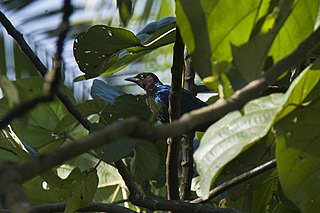
The purple-headed starling, also known as the purple-headed glossy-starling, is a species of starling in the family Sturnidae.

The narrow-tailed starling is a species of starling in the family Sturnidae. It is found in West and Central Africa from Sierra Leone to the Democratic Republic of the Congo.
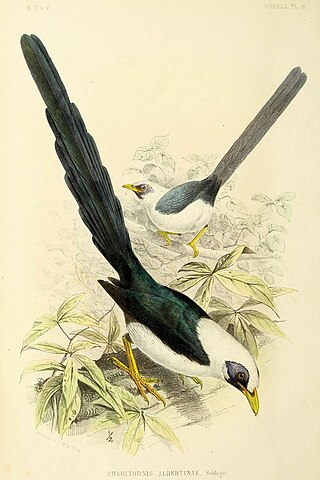
The bare-eyed myna is a large, long-tailed species of starling in the family Sturnidae. Its common name is a reference to the large patch of dark bare skin around the eyes. Due to its superficial resemblance to a magpie, it has been referred to as the Sula magpie in the past. It is endemic to tropical open lowland forests on the Indonesian islands of Taliabu and Mangole in the Sula Islands. It is threatened by habitat loss.

The black-winged myna is a species of starling in the family Sturnidae. The species is also known as the black-winged starling or the white-breasted starling. It is endemic to Indonesia. There are three recognised subspecies: the nominate race, which occurs across much of the island of Java; tricolor, which is restricted to south east Java; and tertius, which is found on Bali and possibly Lombok. The validity of the records on Lombok has been called into question, as there are only a few records and those may represent escapees from the caged-bird trade or natural vagrants. The species has often been assigned to the starling genus Sturnus, but is now placed in Acridotheres because it is behaviourally and vocally closer to the birds in that genus.
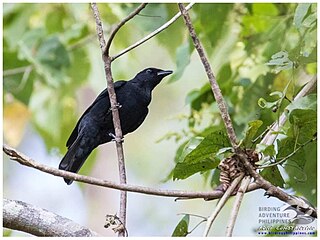
The blackish cuckooshrike or the blackish cicadabird or Luzon graybird, is a species of bird in the family Campephagidae. It is endemic to the Philippines on the islands of Luzon, Catanduanes, Marinduque and Cebu where it is presumed extinct. Some taxonomists place this species in the genus Analisoma.Its natural habitat is tropical moist lowland forest where it is believed to be declining due to habitat loss.

The grand rhabdornis, also known as the long-billed rhabdornis or long-billed creeper, is a species of bird currently placed in the starling family, Sturnidae. It is endemic to Luzon Island in the Philippines. It is sometimes treated as a subspecies of the stripe-breasted creeper.

The Visayan rhabdornis is a species of bird currently placed in the starling family, Sturnidae. It is endemic to the central Philippines on the islands of Negros and Panay. It was previously considered a subspecies of the stripe-breasted rhabdornis. It lives in tropical moist montane forest and is threatened by habitat loss.




















